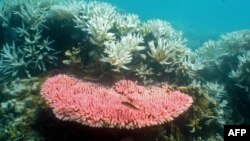As unusually warm ocean temperatures cover the north Pacific, equatorial Pacific, and western Atlantic oceans, scientists of the National Oceanic and Atmospheric Administration [NOAA] expect greater bleaching of corals of Northern Hemisphere reefs through October, potentially leading to the death of corals over a wide area and affecting the long-term supply of fish and shellfish.
Coral bleaching occurs when corals are stressed by changes in environmental conditions such as temperature, light or nutrients. The coral expels the symbiotic algae living in its tissue, causing the tissue to turn white or pale. Without the algae, the coral loses its major source of food and is more susceptible to disease. Scientists note, however, that only high temperatures can cause bleaching over wide areas like those seen since 2014.
“Many healthy, resilient coral reefs can withstand bleaching as long as they have time to recover,” said Mark Eakin, NOAA Coral Reef Watch coordinator. “However, when you have repeated bleaching on a reef within a short period of time, it’s very hard for the corals to recover and survive. This is even worse where corals are suffering from other environmental threats, like pollution or overfishing.”
Additionally, even if corals recover from the bleaching, they are more susceptible to disease. Once corals die, it usually takes decades for the reef to recover -- but recovery is only possible if the reefs are undisturbed, which is extremely difficult to ensure. After corals die, reefs degrade and the structures which corals build are eroded away, providing less shoreline protection and fewer habitats for fish and shellfish.
“The bleaching that started in June 2014 has been really bad for corals in the western Pacific,” Eakin said. “We are worried that bleaching will spread to the western Atlantic and again into Hawaii.”
Earlier this year, NOAA’s Coral Reef Watch four-month Coral Bleaching Outlook accurately predicted coral bleaching in the South Pacific, including the Solomon Islands, Papua New Guinea, Nauru, Fiji, and American Samoa. It also recently predicted the coral bleaching in the Indian Ocean.
The United States, through agencies like NOAA and specific programs such as the NOAA Coral Reef Conservation Program, and in cooperation with international partners, is helping protect the atmosphere and ocean on which life on earth depends.












